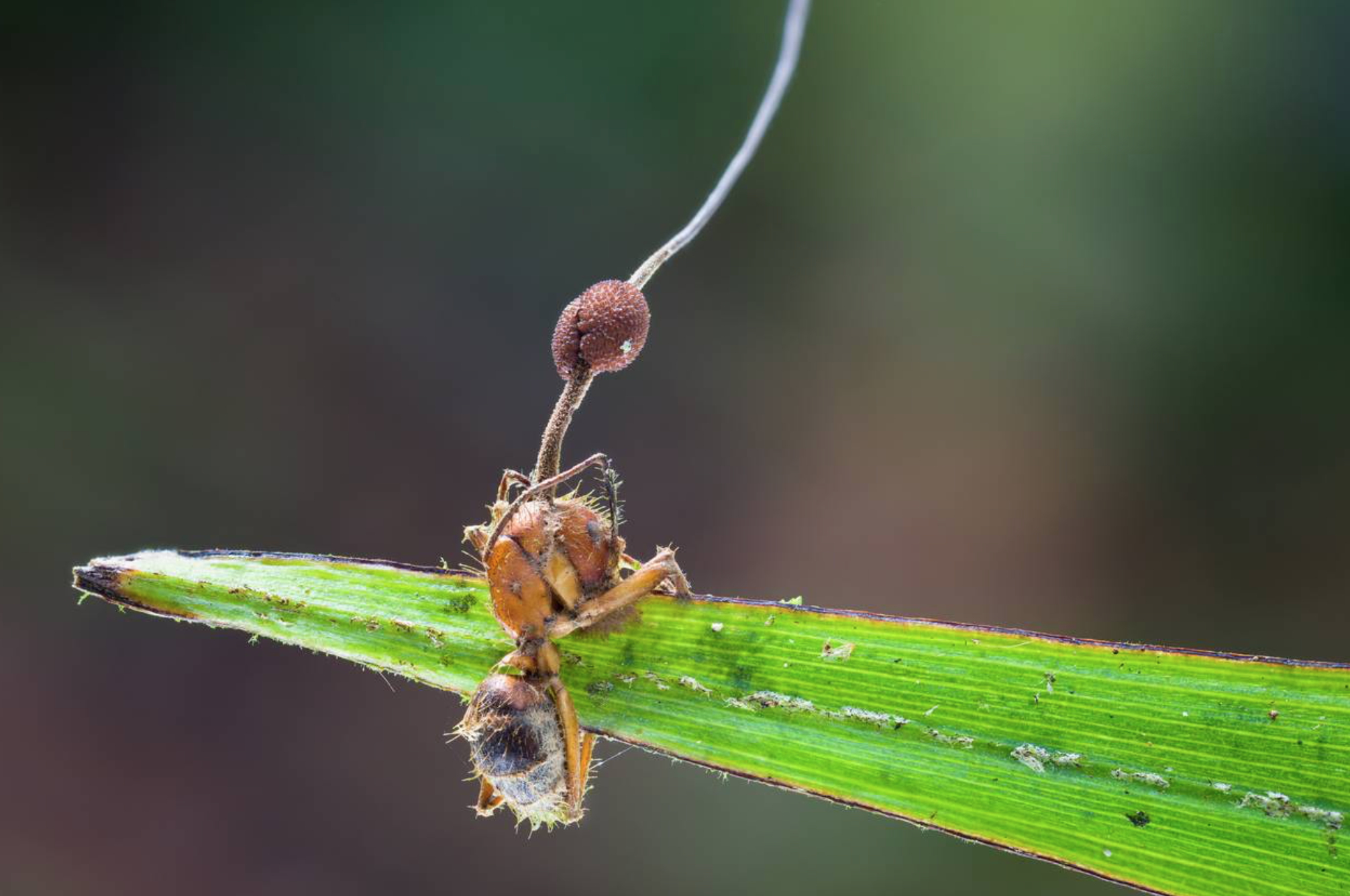Cordyceps fungi are something out of a low budget, 80’s horror film about aliens and zombies. People that learn about Cordyceps for the first time are as captivated, as they are unsettled. In fact, if you type in to a google search bar, “can Cordyceps,” one of the top google suggestions completes the phrase with “infect humans.” This genus of fungus is that bizarre, and a new fossil suggests that they have been functioning in ecosystems for quite a long time.
All Cordyceps fungi are parasitic, with most infecting insects. Out of more than 400 species of Cordyceps fungus, only a small percentage parasitize other fungi. Evolutionarily speaking, this isn’t that crazy of a jump, since fungi and insects alike are made up of the polysaccharide chitin. Thus, Cordyceps can use the enzyme chitinase that breaks down the bonds between chitin molecules in both types of organisms.
The mycoparasite Cordyceps capitata growing out of a false truffle. Photo by Alan Rockefeller.
It’s no surprise that once people see how these fungi work, they quickly google if they too can become zombified by an unassuming fungal parasite. Not to worry, your livelihood is not at stake. No Cordyceps infects any mammal, or vertebrate for that matter. Luckily for us, these species are specialists. Much of the time, through evolutionary processes, a parasite becomes a specialist, and can’t readily infect other species. This ultimately helps the parasite avoid the negative burdens associated with competition. For example, one study in Thailand found that 97 percent of the O. unilateralis fruiting bodies erupted out of a single species of ant (Colobopsis leonardi).
Cordyceps that specialize in parasitizing ant species are most bothersome. The manner in which Ophiocordyceps unilateralis infects its host is enough to keep you up at night. Once spores land on a suitable host, the spores germinate and secrete chitin degrading enzymes to penetrate insect exoskeleton. Once they pass the exoskeleton, they grow and manipulate the behavior of the insect in ways that maximize their own fitness. The ants’ nervous system becomes infiltrated as the ants begin to act erratically, and venture off the main ant highways.
Video describing how infection by a parasitic fungus dramatically changes the behavior of tropical carpenter ants. (29 July 2011)
When the sun is directly overhead, infected ants are then directed by the fungus to locate an area above the forest floor with optimum temperature and moisture content that maximize successful fungal growth. 98% of the ants parasitized by O. unilateralis are found attached to main veins on the bottom, or abaxial regions of leaves. ‘Zombie ants’ secure to the leafs main vain by biting down with their strong mandibles. They are unable to let go, because the growing hyphae within the ant’s head severs its jaw muscles, resulting in zombie ant lockjaw. Securely attached ants ensures that the parasite can infect more hosts, because the spore forming body will remain above the forest floor’s boundary layer. And this is where our fossil comes in.
In 2011, David Hughes and his team published evidence of a 48-million-year-old ‘zombie ant’ death grip on the abaxial surface of a fossilized leaf. Although, some odd invertebrate behavior does sometimes present itself in the fossil record, this is the first abnormal behavior presumably caused by a parasite. The fossil sample came from the Messel Pit located in Hesse, Germany-a fossil site notorious for preserving fine details of biological structures from Earth’s ancient past.
Fossils showing 'zombie ant' death grip. Top right shows Ophiocordyceps unilateralis fruiting through the head of the tropical carpenter ant C. leonardi. From Hughes et al. 2011.
Initially, these leaf scars were thought to be signs of vein-cutting, which is a behavior also used by extant insect species that drains leaf latex, making plant consumption more efficient. Because of the fine details of the fossil, this alternate hypothesis was discounted because the scars lacked the distinctive snips associated with vein-cutting.
This fossil represents the first evidence of plant scars from ‘zombie ants’ parasitized by a fungus. The fine sediments associated with the region this fossil was discovered from help distinguish these scars from separate herbivorous insect behavior. So yes, behavior altering parasitic fungi existed 48 million years ago. It’s important to note, since parasites hardly get any praise, that these organisms are critical in ecosystem functioning. Parasites like Ophiocordyceps unilateralis balance ecosystems by reducing huge ant colonies that would otherwise reduce overall biodiversity. For this reason, parasite diversity is largely used to indicate total species diversity. Just think, without the presence of ant zombifying fungal parasites 48 million years ago, we would not see the same species diversity seen in today’s ecosystems, and we might as well be covered in ants.




